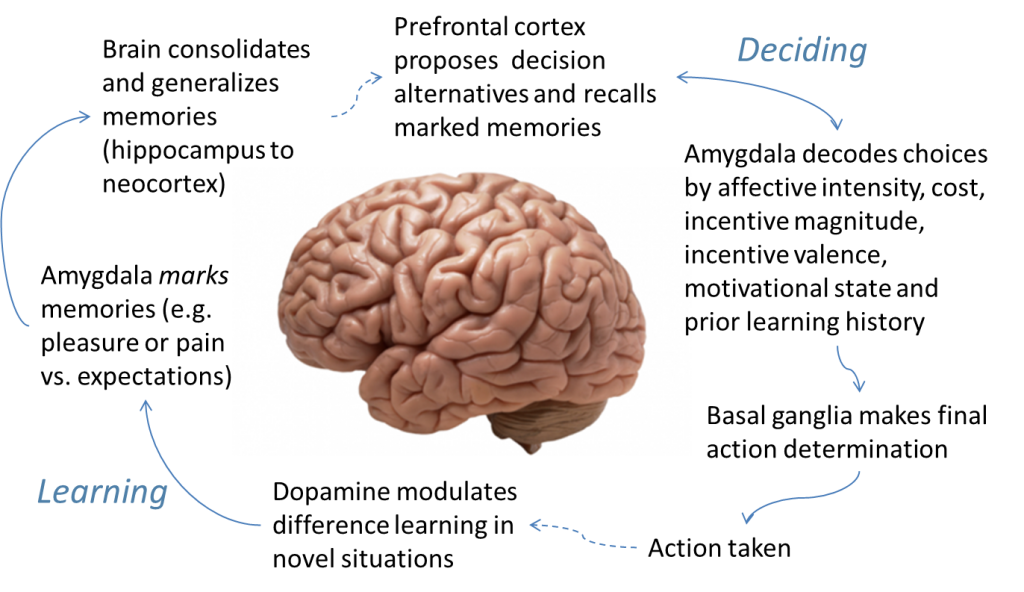Dopamine yields dollars
 “So that’s what happened. When Microsoft pushed their latest Windows update, they shut off a service the printer uses to communicate over the wireless link.” The Hewlett-Packard support rep then clicked on the utility and turned it back on.
“So that’s what happened. When Microsoft pushed their latest Windows update, they shut off a service the printer uses to communicate over the wireless link.” The Hewlett-Packard support rep then clicked on the utility and turned it back on.
“I guess that explains it,” I said, watching the screen while he worked.
“You know, as I look at your list of services, there are some running here that you probably don’t need.”
“Really?”
“Yes. Most people I talk to don’t know these things are running in the background. These particular services don’t do anything useful and just slow things down. Mind if I shut them off?” He asked.
“Go right ahead—I appreciate it!” Sure enough, the scrolling CPU Usage chart showed a perceptible dip. My laptop was indeed running a little faster. “Thank you very much!” I said, with a smile on my face.
We’ve all had this experience. Someone unexpectedly goes the extra mile for us, creating a lasting impression. It’s a random act of kindness that changes our views. We suddenly have a stronger connection to the company because an employee showed us they cared. We tell the story to others—just like I’m doing now. It’s the type of positive brand equity companies simply can’t buy.
Brain pleasing
We remember and value delightful exchanges because they satisfy us on a deep level. Each time we learn, our subconscious compares two values: how rewarding something was versus how rewarding it was expected to be .[1] We automatically adjust our perspectives based on our most recent experiences, and over time our beliefs become established. But when a reward surprises us, the brain releases dopamine, a powerful neurotransmitter. Our amygdala then encodes the emotion-laden memory and our neocortex consolidates the new information along with our past memories.[2]
“Wow” moments in turn influence our decisions. When it’s time to make a choice, our prefrontal cortex recalls salient memories and weighs value among alternatives, engaged in a silent debate with our basal ganglia. If our amygdala informs us one option had unexpected delights, we perceive greater value in it because we’ve experienced greater reward. The bias then sways our choice, often subconsciously.
Missed opportunities
If they’re so impactful, why do moments of “Wow!” happen so infrequently in business? For one thing, people are busy and time is money. Employees typically concern themselves with keeping up rather than spreading joy. In our metrics-driven business world, lack of visibility also plays a role. Managers run things by what they can measure. When it’s easier to quantify the cost of a served customer than it is to measure the revenue from a delighted customer, leaders emphasize the former, not the latter. As a result, thoughtfulness takes a back seat to productivity.
But doing business as usual leaves money on the table. Companies that successfully orchestrate five critical moments in the customer experience build trusting relationships and increase loyalty. It’s not difficult or costly, and a little creativity goes a long way. A handwritten thank-you card, a surprisingly cool product feature, or a random phone call from the CEO bursts dopamine in the brains of unsuspecting customers. And when leaders ensure the stimulus is systematic, moments of delight accumulate along with increased revenue.
Being mindful of the customer’s journey, like the HP support rep was with mine, is the first step to leaving a lasting and profitable impression.
And I’m here to tell you about it.
Did you enjoy this article? Subscribe to Excel-lens now and never miss another post.
Sources:
[1] Caplin, A. and Dean, M. (2008) Dopamine, reward and prediction error, and economics. Q. J. Economics, 123 (2), 663-701
[2] Damasio, A. R. (1996) The somatic marker hypothesis and the possible functions of the prefrontal cortex. Philosophical Transactions of the Royal Society, London. B 351, 1413-1420

